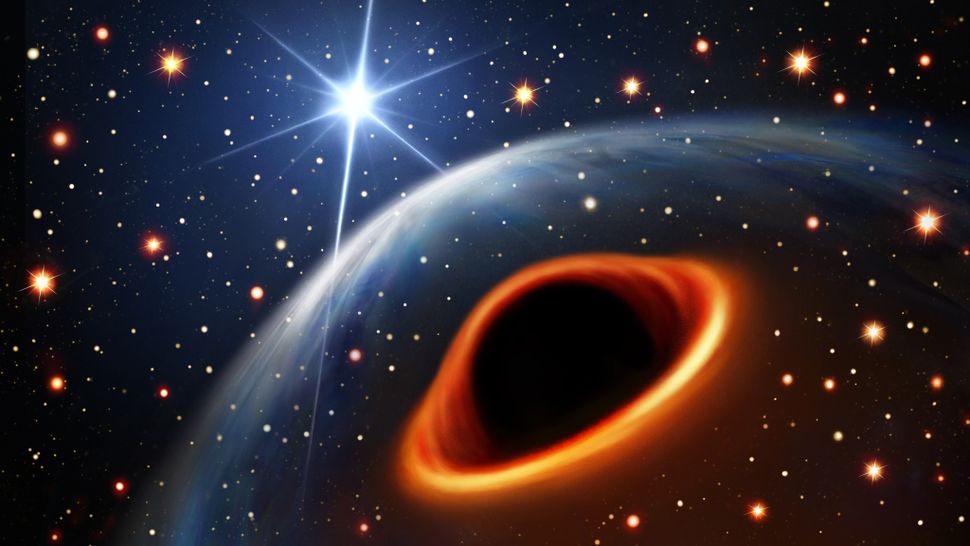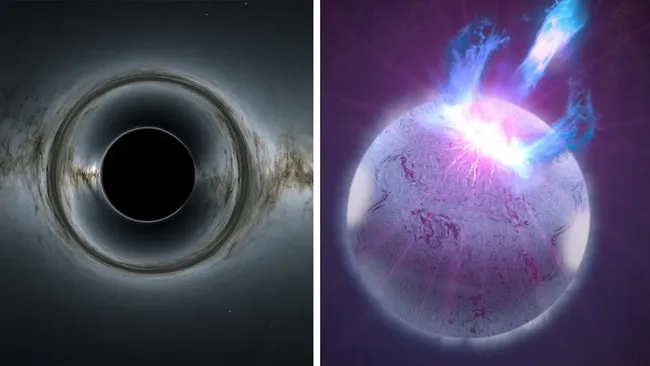The Lightest Black Hole Ever Observed Might Be a New Enigmatic Celestial Object
“Uncovering the true nature of the companion will be a turning point in our understanding of neutron stars, black holes, and whatever else might be lurking in the black hole mass gap.”
Astronomers have made a remarkable discovery within the Milky Way, uncovering an enigmatic entity that surpasses the mass of the heaviest neutron star but falls short of the smallest black hole. This mysterious object holds the potential to assist scientists in establishing a clear distinction between neutron stars and black holes, both of which emerge from the demise of massive stars.
The team leader, Ben Stappers, a professor of astrophysics at the University of Manchester, expressed his enthusiasm for the two potential explanations regarding the nature of this companion. He stated, “Either possibility for the nature of the companion is exciting. A pulsar-black hole system would serve as a significant target for scrutinizing theories of gravity, while a massive neutron star would offer fresh insights into nuclear physics under extremely high densities.”
The MeerKAT Radio Telescope, an assemblage of 64 antennas situated in the Northern Cape of South Africa, facilitated the detection of this celestial enigma. This dense stellar remnant orbits a rapidly rotating neutron star, also known as a “millisecond pulsar,” located approximately 40,000 light-years away within a concentrated cluster of stars referred to as a “globular cluster” in the Milky Way.
Although a system consisting of two neutron stars would be captivating, the presence of a black hole within the mystery object would elevate this system to an immensely coveted radio pulsar-black hole binary system. The pulsar’s highly regular bursts of energy, which can be employed as a timing mechanism, combined with the profound gravitational influence of the black hole, could prove instrumental in pushing the boundaries of Einstein’s theory of gravity, known as general relativity, formulated in 1915.
The pulsar, designated as PSR J0514-4002E, was detected through the faint radio waves it emits as they traverse Earth.
The researchers were able to ascertain that PSR J0514-4002E, which rotates at a frequency of 170 times per second, possesses an orbiting entity due to slight variations in its regular pulses. This orbiting object is incredibly dense, indicating that it is most likely the remains of a massive collapsed star.
Through their investigation, the team determined that the pulsar and the enigmatic object are situated approximately 5 million miles (8 million kilometers) apart, which is roughly 0.05 times the distance between Earth and the sun. Furthermore, they found that the two entities complete one full orbit around each other every seven Earth days.
It is worth noting that the mass of the orbiting object surpasses that of any known neutron star, yet falls short of the mass of any known black hole. This places it within the mass range that is commonly referred to as the black hole mass gap.
Black holes and neutron stars: Spot the difference
When massive stars run out of fuel for nuclear fusion, they can no longer withstand the inward pressure of their own gravity. As a result, the core of the star collapses while the outer layers are expelled in a supernova explosion. This process gives rise to both neutron stars and black holes.
Neutron stars are formed when the collapsing stellar core, now composed of a sea of neutrons, is halted by the quantum properties of these neutrons. These remnants have a mass between 1 and 2 times that of the sun, yet their size is comparable to that of a city on Earth, measuring around 12 miles (20 kilometers) in width.
On the other hand, if the collapsing core exceeds a certain mass, the quantum pressure that keeps neutrons separated is overcome, leading to a complete collapse and the formation of a black hole. However, even a neutron star can surpass this mass limit and transform into a black hole if it accretes material from a companion star, increasing its own mass.
Astronomers believe that if a stellar core still possesses a mass greater than 2.2 times that of the sun after shedding its outer layers and most of its mass, it is heavy enough to give birth to a black hole.
However, there is a discrepancy in our observations. The lightest black holes we have detected so far still have a mass of approximately 5 times that of the sun. This absence of black holes between 5 solar masses and 2.2 solar masses is referred to as the “black hole mass gap,” and it raises doubts about the 2.2 solar mass limit for neutron stars.

Closing the black hole mass gap
Stappers and his colleagues have made a significant discovery while using MeerKat to investigate the globular cluster NGC 1851, situated in the southern constellation of Columba. This finding could potentially hold the key to unraveling a long-standing mystery and bridging the mass gap.
The stars within this ancient cluster are tightly bound together compared to the stars found elsewhere in the Milky Way. The proximity of these stars leads to interactions between them, causing disturbances in their orbits and even resulting in collisions in extreme cases.
The research team speculates that one such collision between two neutron stars might have given rise to the enigmatic object they observed orbiting the pulsar PSR J0514-4002E.
Although the team has not yet determined the exact nature of the companion to PSR J0514-4002E, whether it is a neutron star, a black hole, or an entirely unknown dense cosmic entity, they are certain that this system presents a unique opportunity to study the behavior of matter and physics under extreme conditions.
Dutta, one of the researchers, emphasized that their work with this system is far from over. Unraveling the true identity of the companion will mark a significant milestone in our understanding of neutron stars, black holes, and any other enigmatic entities that may exist within the black hole mass gap.
The team’s findings were recently published in the journal Science on Thursday, January 18th.
This article is republished from space.com under a Creative Commons license. Read the original article.




0 Comments